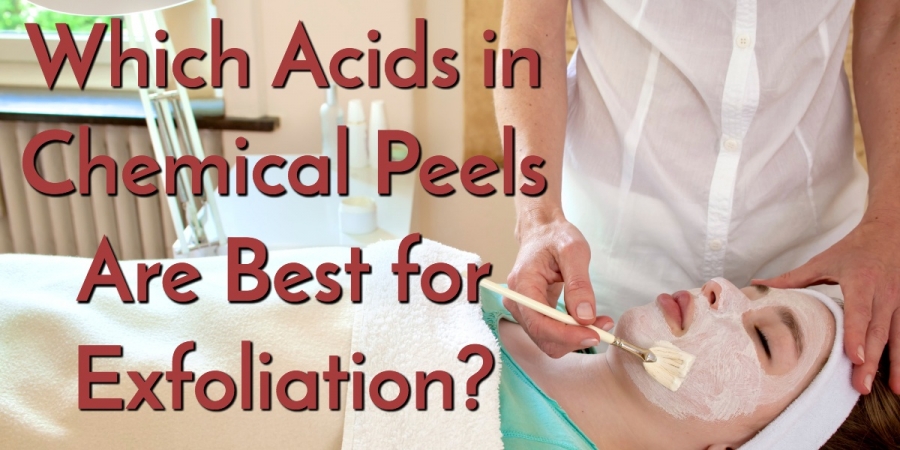When in doubt, we recommend you to consult with your aesthetician. Your aesthetician will give an expert guide to which chemical peel is best for your skin care needs. The general rule is, the stronger the chemical peel, the more drastic the change will be. And therefore the longer the recovery time will take.
For example, if your skin needs minor touch-ups, you can get the lunchtime peel. If you are experiencing severe acne scars and sun damage, however, a stronger peel would be better. The medium or deep peel can help reverse the damage to your skin.
To pick the best acid, choose the one that will most effectively resolve your skin issues while keeping your desired recovery time.
What happens during a chemical peel?
A chemical peel is a procedure that exfoliates the top layer of your skin using an acid. This procedure comes in different degrees of strength depending on what your skin needs. It is ideal for addressing the following skin imperfections:
- Dark spots
- Fine lines
- Dull skin
- Wrinkles
- Sun Spots
- Uneven skin tone
- Uneven skin texture
- Mild acne
In addition to these conditions, chemical peels can help boost the amount of collagen in your skin to keep it looking youthful.
For minor touch-ups: The superficial or lunchtime peel
This peel is named for its expedience and convenience because it can be completed, literally, during a lunch break. The lunchtime peel uses the gentlest acids available: glycolic or salicylic acid. That’s why it requires a very minimal recovery time. These acids are commonly used for over-the-counter products like topical acne medication. This peel would be suitable for those with sensitive skin.
Glycolic or salicylic acid will only gently exfoliate the top layer of your skin. Because it will not go deep enough, it will not trigger a noticeable redness. Unlike the medium and deep peels with longer recovery, you can get a refreshed and clean feeling right away after a lunchtime peel.
Keep in mind that due to the mild acids, you need several treatments until you see noticeable results. Whereas with a stronger exfoliating acid, you won't need to go as often. If you are unable to wait for a longer recovery, a lunchtime peel is a viable option to address your skincare needs.
For moderate sun damage and fine lines: The medium peel
When your skin has experienced damage that glycolic or salicylic acid cannot penetrate, it is time to see if a medium peel is right for you.
This chemical peel uses stronger acids like TCA, i.e. trichloroacetic acid. Some practitioners might also use Jessner's solution. Jessner’s solution contains a combination of salicylic acid, lactic acid, glycolic acid, and resorcinol.
TCA and Jessner's solution are both stronger than glycolic and salicylic acids. These stronger acids will be more effective in penetrating your skin more deeply. Thus, it tends to produce better results because it removes more layers of damaged skin. If you have significant hyperpigmentation or noticeable fine lines, then a medium peel might be more effective.
You can call this chemical peel the happy "medium" between the lunchtime peel and the deep peel. It provides more noticeable results without the longer recovery times associated with a deep peel.
The only downside is that medium peels require a recovery period due to some redness or irritation that may occur. Usually this redness can last up to ten days after the procedure. Because of the medium peel's greater intensity, we recommend that you limit getting one up to four times a year.
For a dramatic change: The deep peel
Deep peels use phenol acids, which are the strongest skin exfoliator peel. We recommend that you only have one deep chemical peel in your lifetime due to the intensity of the procedure. In fact, the effects are so dramatic that they can last for years!
If you have deep wrinkles and an uneven skin tone that medium peels are not fully addressing, you can consider getting a deep peel. The acids used to exfoliate your face are very strong and will deliver the most dramatic results out of your other options available.
Similar with the medium peel, it requires some recovery time. Deep peels could require two to three weeks for complete healing. During recovery, you may experience peeling, blisters, and redness as your skin heals over the course of a few months. It is imperative that you protect avoid the sun for at least 3 weeks as the skin is very susceptible to sun damage.
After you recover, you will have fresh, beautiful skin and a corrected complexion and texture. So, don't worry! If you can invest the time for the recovery and be patient with the healing process, you will enjoy your new look.
If you would like to know more about the kinds of acids used in chemical peels or want to find out about our other cosmetic procedures, contact us.


